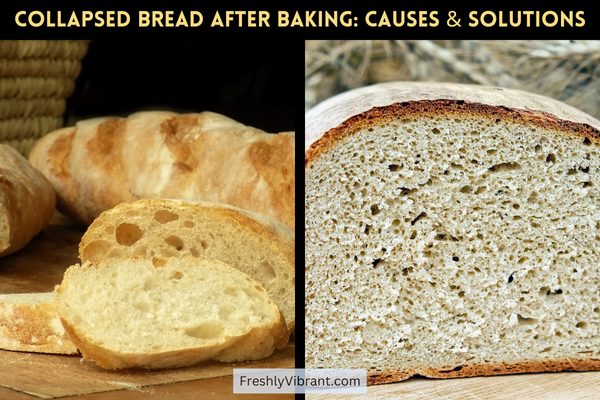Undercooked Bread: Causes & Solutions
Wondering how to fix undercooked bread without tossing it? Here’s your 2025 guide to rescuing soggy centers, doughy crusts, and baking blunders like a pro.
So, you baked a loaf of bread… and instead of golden perfection, you got something that’s crusty on the outside and suspiciously gooey in the middle.
Been there, done that. Look, even the most seasoned home bakers have pulled a “bread brick” or a “loaf lava” out of the oven. But don’t panic!
You don’t need to throw it away, cry into your sourdough starter, or pretend it was “meant to be a pudding.”
This post is your go-to rescue guide for fixing undercooked bread without starting from scratch. Let’s roll up our sleeves and turn that half-baked loaf into a golden masterpiece!
How to Know If Your Bread Is Actually Undercooked

Alright, confession time — I’ve pulled more than a few “oops” loaves out of the oven thinking they were done, only to slice in and find a gooey middle staring back at me like, “Nice try.”
It happens. Bread can be sneaky like that. It looks golden, smells amazing, and even makes that little crackle sound on the cooling rack — but inside? Dough city.
Tap Test: Hollow or Thud?
Here’s a quick trick I learned after ruining my third sourdough loaf in a row — the tap test. Flip the loaf out and give the bottom a firm tap with your knuckles. If it sounds hollow, you’re probably good. If it sounds more like a dull thud, like tapping a sponge or dense cake, that’s your red flag. Thud = not done.
The Internal Temp Trick: Why 190°F–210°F Matters
I used to eyeball doneness until I invested in a cheap digital thermometer. Game-changer. For most breads, you’re aiming for 190°F to 210°F in the center.
Lighter breads like sandwich loaves lean toward 190°F, while denser ones (think sourdough) should hit closer to 205°F–210°F. Anything lower, and you risk a gummy center even if the crust looks perfect.
Visual Cues: That Pale, Sad Crust is a Dead Giveaway
Let’s talk crust. If your loaf is looking kinda pale, especially on the bottom or sides, that’s usually a dead giveaway it’s underbaked. A good bake should be evenly browned, not just golden on top. If it looks like a tan line gone wrong, it probably needs more time.
Slice-and-Snoop: What to Look for When Cutting Into a Questionable Loaf
Okay, so you’ve sliced in and now you’re not sure. The middle looks…suspicious. If the crumb feels doughy, not just moist, or if your knife comes out sticky, that’s underbaked. Another clue? A gummy line right under the top crust — that’s a telltale sign of overproofing or underbaking. Been there.
Can You Rebake Undercooked Bread? (Yes, and Here’s How)
Short answer? Yes, you totally can. And honestly, the first time I did this, I felt like a kitchen wizard. I had this beautiful looking loaf that was raw in the center — not just soft, like actually raw. I was about two seconds from tossing it when I thought, “Wait… what if I just bake it again?” Spoiler: it worked.
Step-by-Step Rebaking Method (Without Drying It Out)
First thing — don’t wait too long. If the loaf’s still warm, pop it back in the oven ASAP. Preheat your oven to 350°F (175°C), then place the bread directly on the rack or a baking sheet.
For a whole loaf, give it another 10–20 minutes, depending on how undercooked it is. For slices, it’s closer to 5–10 minutes. Keep an eye on it, because bread can go from raw to dry real quick.
Adjusting Temperature vs. Time
It’s tempting to just crank up the heat and hope for the best. Don’t. You’ll end up with a crust that’s basically armor and a center that’s still not done. If you already had it at 375°F or above, drop it down to 325°F–350°F and give it more time instead. Low and slow is your friend here.
Best Practices: Whole Loaf vs. Slices
If the loaf is salvageable as a whole, rebake it as-is. But if it’s already been sliced and you just noticed the raw middle, no stress — arrange slices on a tray and bake them flat.
This method’s also great for banana bread or sweet loaves that stay gooey in the center. I’ve saved a whole batch of pumpkin bread this way once, and no one even knew.
When to Tent with Foil (Spoiler: It’s Your New Best Friend)
If the crust is already getting dark but the inside’s still not done, tent the bread with foil. Just loosely cover it so the top doesn’t burn while the heat gets to the center. It’s basically like giving your bread a little sun hat while it finishes tanning.
Common Causes of Undercooked Bread (And How to Prevent Them Next Time)
Let me tell you, I’ve made every mistake in the bread-baking book. I’ve had loaves that were pale and floppy, some that looked done but squished like a stress ball, and one that was so gummy in the middle I thought maybe I invented a new kind of glue.
The silver lining? I now know exactly what not to do — and here’s what you should watch for.
Too Much Water, Not Enough Time: The Hydration Trap
High hydration doughs can be dreamy — think artisan-style bread with open crumbs. But if you overdo it and don’t extend the baking time, you’ll end up with a soggy center every time. Been there. You’ve gotta adjust your bake time and maybe drop the oven temp a bit to let the inside catch up to the crust.
Oven Myths: Why Your Oven Might Be Lying to You
Ovens lie. Mine told me it was 400°F, but an oven thermometer said otherwise — it was barely 340°F. No wonder my bread was always pale inside. A $10 oven thermometer saved me from years of failed loaves. Always trust the thermometer, not the dial.
The Curse of Cold Dough
I once tried baking a sourdough straight from the fridge — looked great on the outside, but the middle? Ice-cold and raw. Cold dough = uneven baking. If you’re baking chilled dough, let it rest at room temp for 30–60 minutes before it hits the oven.
Underproofing vs. Overproofing — Yes, It Matters!
Here’s where things get fussy. Underproofed dough is tight and dense, which means it’ll bake unevenly and stay raw in the middle. Overproofed dough, on the other hand, can collapse and bake weirdly gummy. Your dough should spring back slowly when poked, not instantly or not at all. That little poke test? Gold.
Skipping the Thermometer? Big Mistake.
If you’re not using an internal thermometer, you’re basically guessing. And guessing = mistakes. That little temp check (remember: 190°F–210°F) has saved me so many times. Even if you think it’s done, a quick temp read tells the truth.
Quick Fixes for Different Types of Bread
Different breads = different personalities. Some are chill, some are dramatic divas that fall apart if you look at them funny (looking at you, banana bread). But here’s the good news — even if you botched the bake a bit, most undercooked breads can be saved if you know the tricks. And yes, I’ve tested all of these after many kitchen fails.
Sourdough: How to Rebake Without Killing the Crust
Sourdough is a beast of its own. I remember pulling out this beautiful crusty loaf, only to find the inside practically raw. To save it, I popped it back in at 350°F directly on the oven rack, but tented it with foil to protect the crust. You can also flip it upside down halfway through to get heat right where it’s needed. Just don’t overbake — sourdough can dry out fast once it’s crusty.
Banana Bread or Sweet Loaves: Handling a Gooey Middle
If you’ve ever made banana bread and the top looked golden but the middle jiggled like jelly — welcome to the club. Instead of tossing it, I slice it in half lengthwise and put the halves cut side down on a sheet pan. Bake at 325°F for 10–15 minutes. It firms up without burning the sugar-heavy crust.
Rolls & Buns: Save the Batch with a Second Bake
Rolls are surprisingly forgiving. I once underbaked a whole tray of dinner rolls and didn’t realize until people were biting into sticky centers (oops). Quick fix? Slice them in half like sliders, spread them on a sheet tray, and bake for another 5–10 minutes. Bonus — they come out with a toasty edge and taste almost like they were meant to be that way.
No-Knead Breads: To Slice or Not to Slice Before Fixing?
No-knead bread can be deceptively heavy, and underbaking is common. If it’s just slightly doughy, rebake the whole loaf. But if it’s flat-out raw inside, go ahead and slice it. Lay the pieces flat and rebake at a lower temp (around 325°F). This method gets the inside fully cooked without turning the crust to concrete.
When It’s Beyond Repair: What to Do With a Totally Undercooked Loaf
Sometimes, no matter how hard you try, the bread just… isn’t gonna make it. I’ve had loaves so raw in the middle they could’ve gone back in the mixer. If you’ve rebaked, resliced, retried, and it’s still a sticky mess, don’t beat yourself up. It happens — and guess what? That “failed” loaf isn’t a total loss. You’ve got options.
Make Bread Pudding or French Toast (Hello, Breakfast!)
One time I had this cinnamon swirl loaf that turned out weirdly dense and doughy in the middle. Totally disappointing — until I cubed it, soaked it in eggs and cream, and turned it into the most insanely good French toast bake. That gooey center? Became an asset. Bread pudding works the same way. Let it soak and bake it low and slow — the underbaked bits actually help the texture.
Turn It Into Breadcrumbs or Croutons (Nobody Will Know)
Dry the slices out completely in the oven (300°F for 20–30 minutes), then blitz them into breadcrumbs. Or cube them up, toss with olive oil and seasoning, and make croutons. No one’s ever asked if my Caesar salad was built on a baking fail. You’re not just saving bread — you’re stocking your pantry.
Cube and Freeze for Soups or Stuffings
I keep a freezer bag of “bread flops” just for soup nights. Cubed and frozen, they’re perfect for making stuffing or tossing into brothy soups where texture matters less. Once it soaks up broth or gravy, nobody’s gonna know it started life half-baked.
Embrace the “Happy Accident” and Call It Rustic
Okay, this one’s half-joke, half-truth — but I’ve totally served a sad-looking loaf at dinner and just called it “rustic artisan-style.” If it tastes good and holds shape (sort of), slice it thin and own it. Add some butter, a little jam, and suddenly it’s “country-style homemade” instead of “oops.”
Conclusion
So, undercooked bread isn’t the end of the world—or even the end of your loaf.
With a few tweaks and a bit of kitchen confidence, you can save it, serve it, and maybe even brag a little. Next time your bread pulls a gooey surprise on you, don’t toss it.
Fix it like the savvy baker you now are. And hey, every bread fail is just a warm-up for your next glorious bake. 🧑🍳






